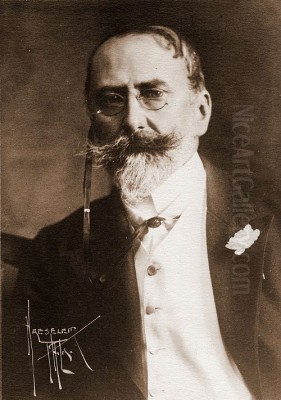
William Merritt Chase stands as a towering figure in the landscape of American art. Active during a transformative period from the late 19th to the early 20th century, he was not only a prolific and influential painter but also one of the most significant art educators of his generation. His work bridged the gap between traditional European techniques and the burgeoning modern spirit in America, establishing him as a key proponent of American Impressionism. Chase's legacy is twofold: a rich body of work characterized by vibrant brushwork and luminous light, and a profound impact on countless students who would go on to shape American art history.
Early Life and Artistic Awakening in Indiana
William Merritt Chase was born on November 1, 1849, in Williamsburg, Indiana, a town later known as Nineveh. His family, headed by his father, a local merchant dealing in shoes and other goods, relocated to Indianapolis when Chase was twelve. It was in Indianapolis that the young Chase first began to show a serious inclination towards art, an interest not initially encouraged by his practical-minded family who perhaps envisioned a future for him in the family business.
Despite the lack of early familial support for an artistic career, Chase's talent was evident. He sought out local instruction, initially studying under Barton S. Hays, a self-taught artist known primarily for his portraiture. Hays recognized Chase's potential. Further guidance came from Jacob Cox, another prominent Indianapolis painter. These early mentors provided Chase with foundational skills and, crucially, encouragement to pursue his passion more formally. The artistic environment in Indianapolis was limited, however, and it soon became clear that Chase would need to seek training elsewhere to fully develop his abilities.
Formative Years: New York and the Munich Influence
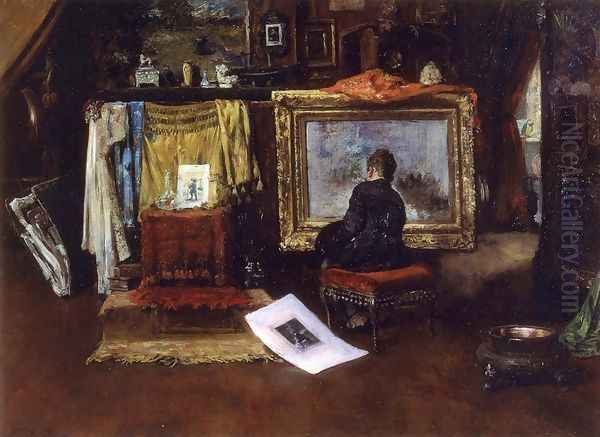
In 1869, seeking broader horizons, Chase moved to New York City. His Indianapolis teacher, Barton S. Hays, had provided him with connections, including an introduction to Joseph Oriel Eaton. Chase enrolled for a brief period at the National Academy of Design, studying under Lemuel Wilmarth, who himself had studied in Europe, notably under Jean-Léon Gérôme in Paris. This initial exposure to the New York art world and its academic structures was important, but Chase's ambition pushed him further. Financial constraints, however, forced a temporary return to the Midwest, where he moved to St. Louis and assisted his family.
A pivotal opportunity arose in 1872. Recognizing his exceptional talent, a group of patrons in St. Louis sponsored Chase's travel to Europe for advanced study. He chose Munich, Germany, a major art center rivaling Paris at the time, and enrolled in the prestigious Royal Academy of Fine Arts (Königliche Akademie der Bildenden Künste). This decision would profoundly shape his early artistic identity. In Munich, he studied under influential figures like Alexander von Wagner and the history painter Karl von Piloty. Perhaps most significantly, he absorbed the teachings of Wilhelm von Diez, known for his painterly approach and emphasis on bravura brushwork.
The Munich school favored a dark, tonal palette and vigorous brushwork, often inspired by 17th-century Dutch and Spanish masters like Frans Hals and Diego Velázquez. Chase excelled in this environment, quickly mastering the techniques and gaining recognition. During his time in Munich, he formed crucial friendships with fellow American artists studying abroad, most notably Frank Duveneck and John Henry Twachtman. These artists, sometimes referred to as "The Duveneck Boys," shared studios, traveled, and influenced one another significantly.
In 1877, Chase, along with Duveneck and Twachtman, spent nine months in Venice. This period marked a subtle but significant shift in his work. While still retaining the technical facility honed in Munich, the light and atmosphere of Venice began to brighten his palette. He started experimenting with capturing fleeting effects of light and color, foreshadowing his later embrace of Impressionism. His European experience, particularly his exposure to Old Masters and the vibrant contemporary art scene, provided him with a technical mastery and cosmopolitan perspective that would set him apart upon his return to the United States.
Return to America and Rise to Prominence

In 1878, equipped with a sophisticated European training and a growing reputation, William Merritt Chase returned to New York City. He arrived at a moment when American art was seeking new directions, moving away from the dominance of the Hudson River School towards more international styles. Chase was perfectly positioned to become a leader in this transition. He immediately took up a teaching position at the newly formed Art Students League of New York, an institution founded by artists seeking an alternative to the more conservative National Academy of Design.
His teaching post at the League quickly established him as a dynamic and influential instructor. His European experience, technical virtuosity, and charismatic personality attracted numerous students. Simultaneously, Chase began actively exhibiting his work, showcasing paintings that reflected his Munich training but also hinted at the lighter palette influenced by his time in Venice and his admiration for artists like Édouard Manet and James McNeill Whistler.
Chase played a key role in challenging the established art institutions. He became a founding member and later president of the Society of American Artists (SAA). The SAA was formed in 1877 by artists, including Chase upon his return, who felt the National Academy of Design was too resistant to new styles and exhibition practices. This move positioned Chase at the forefront of the progressive art movement in America, advocating for greater openness to European trends and a higher standard of professionalism. His own work, sophisticated and technically brilliant, served as an exemplar of the new direction he championed.
The Tenth Street Studio: A Hub of Art and Culture
Shortly after his return from Europe, Chase took over the grand studio space previously occupied by Albert Bierstadt in the Tenth Street Studio Building in New York City. This was no ordinary workspace; Chase transformed it into a showplace, a carefully curated environment that reflected his artistic tastes and served as a social and professional hub. Filled with paintings (his own and others'), luxurious textiles, antiques, objets d'art, musical instruments, and exotic bric-a-brac collected during his travels, the studio became one of the most famous artistic interiors in America.
The Tenth Street Studio was more than just a place for Chase to paint; it was a statement. It projected an image of the artist as a sophisticated man of the world, a connoisseur, and a successful professional. It served as a backdrop for his portrait painting, a classroom for private students, and a salon where artists, collectors, critics, and society figures gathered. The studio's elaborate and eclectic decor frequently appeared in his paintings, such as the notable series depicting its interiors, including The Inner Studio, Tenth Street (also known as In the Studio).
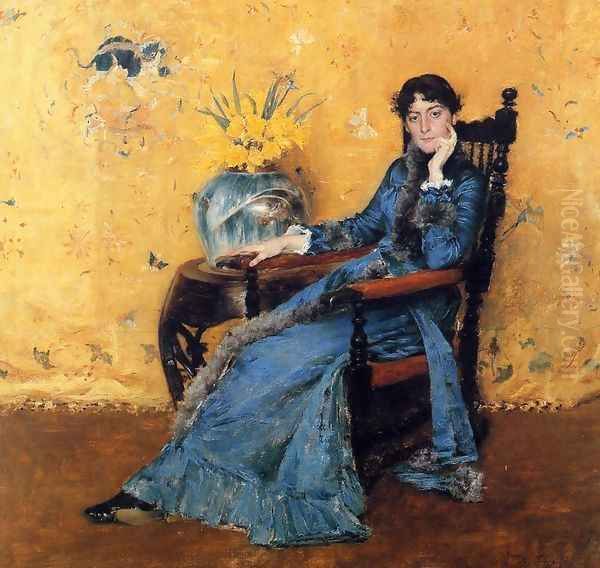
These paintings of his studio are significant not only as records of this iconic space but also as demonstrations of Chase's technical skill. He reveled in depicting the varied textures of fabrics, the gleam of polished wood and metal, and the interplay of light within the cluttered but artfully arranged space. The studio embodied Chase's belief in the importance of aesthetics in daily life and the role of the artist as a tastemaker. It remained his primary base of operations and a center of artistic life in New York until he was forced to give it up due to financial pressures in 1895.
Chase the Painter: Style and Subjects
William Merritt Chase was a remarkably versatile artist, proficient in oil painting, watercolor, pastel, and etching. His subject matter was equally diverse, encompassing portraits, landscapes, interiors, and still lifes. While his early work bore the hallmarks of his Munich training with its darker palette and emphasis on dramatic brushwork, he is best known for the Impressionist style he developed throughout the 1880s and beyond.
Impressionist Sensibilities
Influenced by his time in Europe, his admiration for Manet and the French Impressionists, and his friendship with American Impressionists like Twachtman, Chase increasingly adopted a brighter palette and a looser, more spontaneous brushstroke. He became adept at capturing the fleeting effects of light and atmosphere, whether in a sun-drenched landscape, a figure study, or the reflective surfaces of a still life. However, Chase's Impressionism was distinctly American. While he embraced the techniques of capturing light and color, his work often retained a greater sense of structure and solidity compared to his French counterparts like Claude Monet. He focused on applying these techniques to American subjects – the parks and shores of New York, the domestic lives of his family, and the landscapes of Long Island.
Mastery of Portraiture
Chase was one of the leading portrait painters of his era in America, rivaled perhaps only by his contemporary, John Singer Sargent. He painted numerous prominent figures, fellow artists, and family members. His portraits are characterized by their directness, psychological insight, and technical brilliance. He often employed an alla prima (wet-on-wet) technique, allowing for spontaneity and freshness. Works like Portrait of Miss Dora Wheeler (1883) showcase his elegant composition and ability to capture the sitter's personality. His self-portraits, such as the flamboyant Keying Up – The Jester (c. 1875), reveal his confident persona and technical flair. One of his most celebrated portraits is The Lady in Pink (Portrait of Mrs. Leslie Cotton) (c. 1888-89), admired for its delicate color harmonies and graceful depiction of the sitter.
Capturing the Outdoors: Landscapes of Shinnecock and Beyond

Chase's landscape paintings, particularly those created during his summers at Shinnecock Hills on Long Island, are considered cornerstones of American Impressionism. From 1891 to 1902, he ran the Shinnecock Hills Summer School of Art, one of the first and most important outdoor summer art schools in America. Teaching en plein air (outdoors), he encouraged his students—and demonstrated in his own work—to directly observe and capture the effects of sunlight on the coastal landscape. His Shinnecock paintings, such as Idle Hours (c. 1894) and numerous views of the dunes and bay, are filled with bright light, fresh color, and a sense of immediacy. He also painted urban landscapes, capturing scenes in Brooklyn's Prospect Park and Manhattan's Central Park with similar vibrancy. Works like Harbor Scene (Brooklyn Docks) (c. 1888) show his ability to find painterly beauty in everyday urban and industrial settings. Other American Impressionists like Childe Hassam and Theodore Robinson also explored similar themes, but Chase's Shinnecock works hold a unique place.
The Allure of Still Life
Chase was a master of still life painting throughout his career. His Munich training, with its emphasis on painterly technique and the study of Old Masters, served him well in this genre. He was particularly famous for his paintings of dead fish, often depicted gleaming on platters or tables. These works were demonstrations of pure painting prowess, executed quickly (alla prima) to capture the shimmering scales and textures before the subjects spoiled – legend has it he would sometimes return the fish to the market after painting them. These still lifes, influenced by artists like Antoine Vollon and echoing the traditions of Dutch 17th-century masters, showcased his bravura brushwork and his ability to find beauty and artistic challenge in humble subjects. He also painted arrangements of brass and copper pots, fruit, and vegetables, always focusing on the play of light on different surfaces and textures.
Chase the Educator: Shaping American Art
While William Merritt Chase's reputation as a painter is significant, his role as an educator was arguably just as impactful, if not more so, on the course of American art. He was a charismatic, dedicated, and highly influential teacher for nearly four decades, shaping the skills and perspectives of generations of artists. His teaching career spanned several major institutions and his own innovative schools.
Founding Institutions: The Chase School and Shinnecock
After years of teaching at the Art Students League, Chase sought to create an institution based on his own pedagogical principles. In 1896, he founded the Chase School of Art in New York City. His aim was to offer a more liberal and progressive alternative to traditional academic training. The school emphasized individuality and practical technique over rigid dogma. Although Chase left the school after a few years due to disagreements, it thrived and eventually evolved into the renowned Parsons School of Design, a testament to its strong foundation.
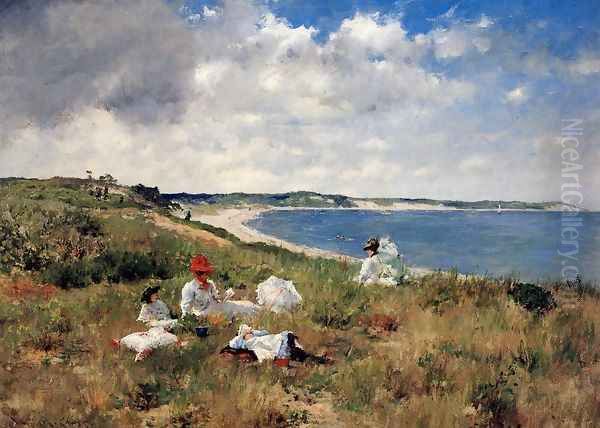
Equally important was the Shinnecock Hills Summer School of Art on Long Island, which he directed from 1891 to 1902. This was one of the largest and most successful outdoor art schools of its time. Hundreds of students, mostly women, flocked there each summer to learn Chase's methods of plein-air painting. The school played a crucial role in popularizing Impressionism in America and provided invaluable training in capturing the effects of natural light.
Teaching Philosophy: Technique and Individuality
Chase's teaching philosophy was pragmatic and inspiring. He famously advised students to "Take the best from everything." He encouraged them to study the Old Masters but also to engage with contemporary art movements. He emphasized technical proficiency, particularly strong drawing skills and confident brushwork, believing that mastery of craft was essential for artistic expression. Yet, he strongly discouraged imitation, urging students to develop their own unique styles and perspectives. He was known for his dynamic demonstrations, often completing a painting sketch (a "pochade") in front of his class in a short time to illustrate principles of composition, color, and technique. His critiques were known for being direct but constructive.
A Legacy of Students: Influencing Modernism
The list of artists who studied with Chase reads like a who's who of early American Modernism. His students included figures who would go on to achieve great fame and work in diverse styles, demonstrating the breadth of his influence rather than the imposition of a single style. Among his most notable pupils were:
Georgia O'Keeffe: A foundational figure of American Modernism, known for her abstract flower paintings and New Mexico landscapes.
Edward Hopper: Renowned for his evocative depictions of American solitude and urban life.
George Bellows: A leading member of the Ashcan School, famous for his gritty urban scenes and dynamic boxing paintings.
Marsden Hartley: An important early American Modernist painter, associated with Expressionism and known for his powerful Maine landscapes.
Charles Sheeler: A key figure in Precisionism, known for his paintings and photographs of industrial subjects.
Charles Demuth: Another major Precisionist, also known for his delicate watercolors and "poster portraits."
Rockwell Kent: Painter, printmaker, and illustrator known for his stark landscapes.
Joseph Stella: An Italian-American Futurist painter, famous for his depictions of the Brooklyn Bridge.
Charles Hawthorne: An influential painter and teacher in his own right, who founded the Cape Cod School of Art.
Guy Pène du Bois: Painter and art critic associated with the Ashcan School circle.
Julian Onderdonk: Known for his Impressionist landscapes of Texas bluebonnets.
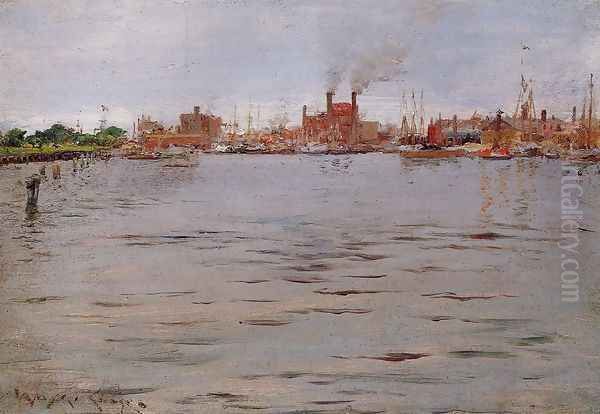
Louise Upton Brumback, Emma Lampert Cooper, Edward Charles Volkert, Ella Sophonisba Hergesheimer, Dora Wheeler were among the many other talented artists who benefited from his instruction.
Chase's ability to nurture such diverse talents underscores his effectiveness as a teacher who prioritized individual artistic development alongside technical skill. He taught not only at his own schools and the Art Students League but also at the Brooklyn Art Association, the Pennsylvania Academy of the Fine Arts (PAFA) in Philadelphia, and later in California, spreading his influence across the country.
Personal Life and Persona
Beyond his professional life, William Merritt Chase cultivated a distinctive public persona. He was known for his dapper appearance – often sporting a well-groomed mustache and goatee, a carnation in his buttonhole, impeccable suits, and sometimes a straw boater hat or a high silk hat. This careful presentation reinforced the image of the artist as a sophisticated professional, a cosmopolitan figure akin to his friend James McNeill Whistler. Anecdotes abound about his charismatic, if sometimes eccentric, personality. He was known to bring his Russian wolfhounds into the classroom, adding to his unique flair.
In 1886, Chase married Alice Gerson, who became his lifelong companion and the subject of many of his paintings. Together, they raised a large family, eventually having nine children. His wife and children frequently appear in his work, particularly in domestic interiors and outdoor scenes from their summers on Long Island. These paintings, such as A Friendly Call (1895) or Sunlight and Shadow (c. 1884), offer intimate glimpses into the comfortable, cultured life of his family and stand as some of his most charming works.
Despite his professional success and cultivated image, Chase faced periods of financial difficulty. Supporting a large family and maintaining his grand studio and lifestyle was challenging. He had experienced poverty early in his career, forcing his return from New York to St. Louis. Later, in 1895, financial pressures led him to give up the famous Tenth Street Studio and auction off its contents. Nevertheless, he remained resilient, continuing to paint prolifically and teach actively until the end of his life.
Later Years and Enduring Legacy
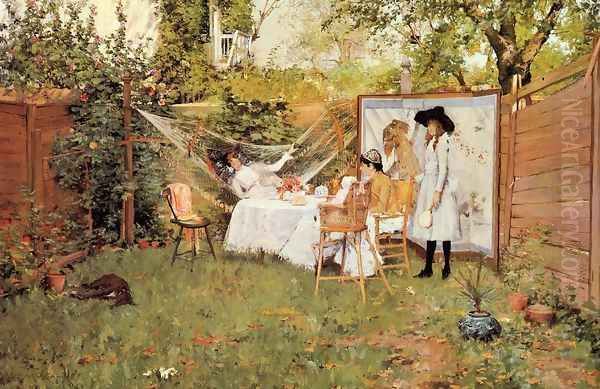
William Merritt Chase remained an active painter and teacher into the 20th century. He continued to travel, including trips to Europe, and spent his final summers teaching in Carmel-by-the-Sea, California, where he influenced the development of California Impressionism. He received numerous awards and honors throughout his career, solidifying his position as a leading figure in American art.
Chase died in his New York home on October 25, 1916, at the age of 66. His death marked the end of an era for many in the American art world. His influence, however, continued through his vast body of work and the many students he had inspired. While some aspects of Impressionism were being challenged by newer, more radical forms of Modernism (some pioneered by his own students), Chase's emphasis on strong technique, direct observation, and artistic individuality remained relevant.
Today, William Merritt Chase is recognized as a pivotal figure in American art history. He successfully navigated the transition from 19th-century academic traditions to the modern era, embracing Impressionism and adapting it to an American context. His paintings are celebrated for their technical brilliance, vibrant energy, and appealing subject matter. His former home and studio at Shinnecock Hills is now a National Historic Landmark, recognizing its importance in American art education. As both a master painter and a transformative educator, Chase left an indelible mark on the art of the United States.
Conclusion: A Dual Legacy
William Merritt Chase occupies a unique and vital position in the story of American art. He was a painter of exceptional skill and versatility, whose work captured the spirit of his time with vibrancy and elegance. From the dark tones of his Munich period to the sunlit canvases of his Impressionist maturity, his art demonstrated a mastery of technique wedded to a keen observation of the world around him. Whether painting a formal portrait, a casual family scene, a windswept landscape, or a gleaming still life, Chase brought an undeniable energy and painterly confidence to his subjects.
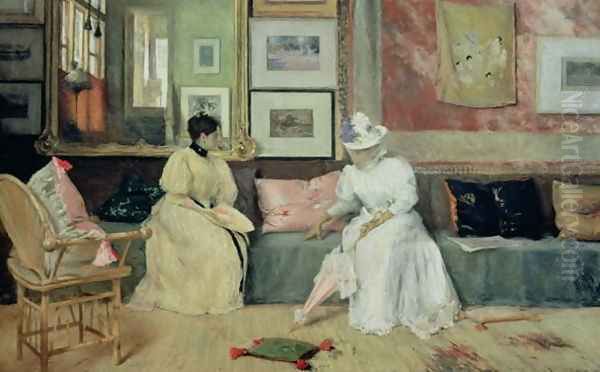
Simultaneously, his legacy as an educator is immense. For decades, he stood as one of the most respected and sought-after art teachers in America. By founding influential schools and teaching countless students—many of whom became major artists themselves—Chase fundamentally shaped the direction of American art in the early 20th century. He championed technical skill but celebrated individuality, fostering a generation of artists who would explore diverse paths, from Realism to Modernism. William Merritt Chase remains a cornerstone figure, an artist whose dual contributions as a painter and teacher continue to resonate.